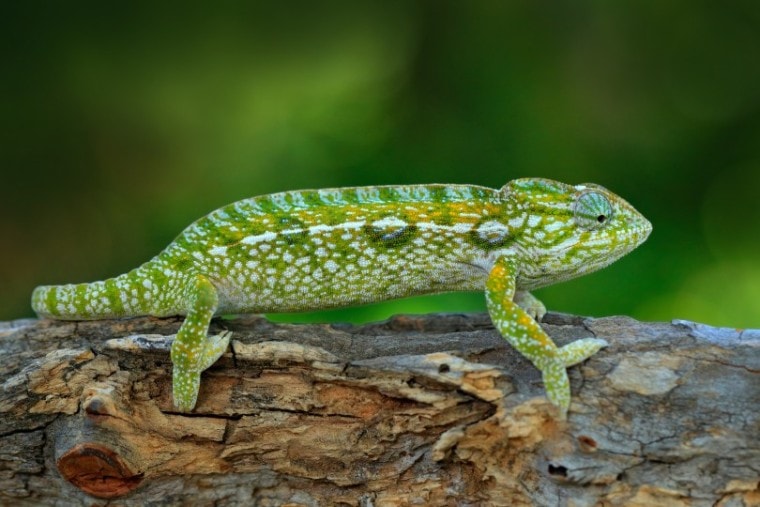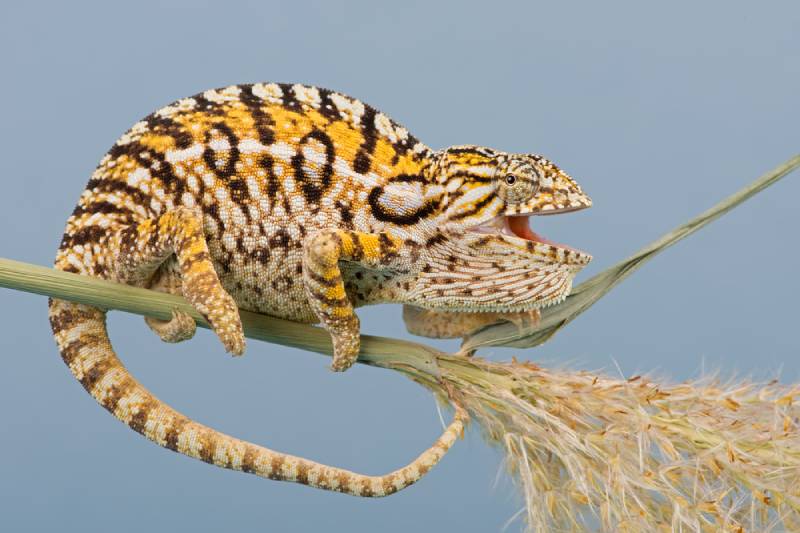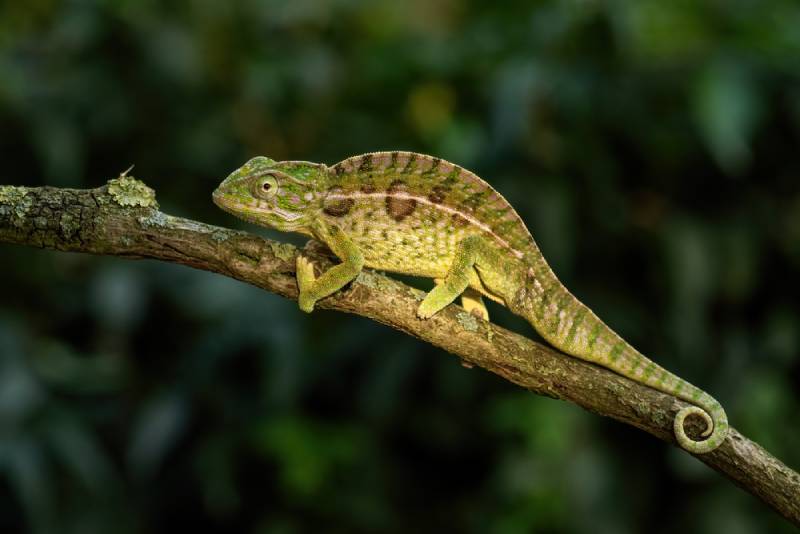
Carpet chameleons are a hobbyist favorite, native to Madagascar. These are among the most common chameleons you can find—filling pet shops and exotic online sites all over. But is this species suitable for you?
If you aren’t familiar with the carpet chameleon, you’re doing the right thing by researching before purchasing. Even though these creatures are plentiful, they require very specific living conditions—and they can be incredibly sensitive to their surroundings. Read on to learn all there is to know about them!
Quick Facts About Carpet Chameleons

| Species Name: | Furcifer lateralis |
| Family: | Chamaeleonidae |
| Care Level: | Intermediate |
| Temperature: | 70-95 degrees Fahrenheit |
| Temperament: | Shy, timid |
| Color Form: | Green, black, orange |
| Lifespan: | 3 years |
| Size: | 6-10 inches |
| Diet: | Insectivore |
| Minimum Tank Size: | 18” x 18” x 36” |
| Tank Setup: | Logs, plants, hides |
| Compatibility: | Difficult |
Carpet Chameleon Overview
Carpet chameleons are arboreal creatures, meaning they live life in the wild up in trees. Think of a carpet chameleon as a living mood ring, rather than the popular misconception that they change colors based on their surroundings—which isn’t true.
Instead, these chameleons change their color depending on environmental and nervous system factors, such as temperature and emotional changes. They can fluctuate between a few color ranges, but the outcome is generally not intense.
Like many chameleons, carpet chameleons are incredibly sensitive and difficult to maintain, especially if you’re inexperienced. They require very specific diets and surroundings to live an entire life in captivity.
How Much Do Carpet Chameleons Cost?
The price of a carpet chameleon can vary based on several factors. However, the average cost falls somewhere between $100 and $500. Sometimes, you can get lucky and find a person who is just looking to give their chameleon to a good home for free.
Keep in mind that you also need lots of supplies to get started. There is no skipping the basics, as these are fragile creatures that need adequate care.
For the setup, including enclosures, substrate, hides, plant life, and diet, you can expect to spend anywhere from $300 to $800.
Typical Behavior & Temperament
Carpet chameleons are reserved and shy, so they aren’t the type to hang out on your shoulder. Once they are out of their habitat, they can get stressed very quickly, which can cause a wide range of issues for their overall health.
These creatures prefer to be on a branch or log basking in their enclosure. They leisurely move from branch to branch, absolutely requiring space to climb. They like to stay out of sight, hiding under branches and inside hideouts.
Females reach sexual maturity by 12 months. They will lay eggs for the duration of their lives after that.

Appearance & Varieties
Carpet chameleons reach the same length at maturity, regardless of gender. Each of them grows up to 10 inches total. They can change color depending on their mood, temperature, and sexual preparedness.
Males tend to be very vibrant green, whereas females can show a myriad of bright colors. Each has classic bands and stripes around their throats and lips. Males tend to be leaner while females are stockier.
How to Take Care of Carpet Chameleons
Having precise conditions in the enclosure is crucial for the well-being of your carpet chameleon. You must develop a habitat that closely mimics what they would have in nature.
Habitat, Tank Conditions & Setup
As far as living space, here is what you need to accommodate your chameleon.
Enclosure
Since chameleons spend their life in trees, you will need a terrarium that is taller than it is wide. You will need a space that measures at least 18” by 18” by 36” inches for an adult—but more is always better.
Substrate
The terrarium should be lined with pea gravel or clay pellets for optimal drainage.

Temperature
Like many other cold-blooded critters, there should be various temperatures available in the enclosure. They need to be able to regulate their bodies accordingly.
| Basking: | 90-95 degrees F |
| Top of terrarium: | 80-85 degrees F |
| Bottom of terrarium: | 70-75 degrees F |
Plant Life
Chameleons need lush, healthy plants inside of their enclosure for climbing and shade.
Before buying, you have to consider that you’ll also be responsible for keeping your plants healthy, as well as your chameleon.
Humidity
Carpet chameleons love hot, humid weather. Their enclosure should maintain humidity levels between 50% and 60% continually. Place a hydrometer in their terrarium to monitor levels.
Lighting
Chameleons require lighting that mimics natural daylight and nighttime cycles. They benefit significantly from dual-fluorescent fixtures.
Do Carpet Chameleons Get Along with Other Pets?
Carpet chameleons can coexist peacefully with each other—but two males shouldn’t share the same enclosure.
There is always a chance that some won’t get along well with others, despite gender. So, if you opt for more than one, you should always have a separate enclosure just in case the partnership doesn’t work out.

What to Feed Your Carpet Chameleons
Carpet chameleons love all sorts of tasty insects.
Juveniles should eat one helping of insects per day—as much as they can in one sitting. Typically, this totals about 12 insects per day.
Adults should eat every other day, and they eat significantly less, roughly 6 insects per feeding.
Keeping Your Carpet Chameleons Healthy
Carpet chameleons can be finicky and very hard to keep. They are ultra-sensitive to stress and environmental surroundings. So, one of the primary things you need to do is make sure your chameleon feels as comfortable as possible.
Before bringing your carpet chameleon home, you need to find an exotic vet in your area. You can’t take a reptile to traditional vets, as they don’t have the specialization required to care for them efficiently.
These chameleons are susceptible to various illnesses and problems.
If you notice any peculiar behavior or physical abnormalities, don’t hesitate to get them to the vet.
Breeding
If you have no experience, you might want to avoid breeding carpet chameleons until you have owned a few. Since chameleons are so remarkably hard to care for, breeding them can bring on even more risks.
But if you are familiar with the species, you can try your hand at breeding.
A good recommendation is to wait until the female lays her first eggs before mating occurs. After a few weeks, you can reintroduce the female to the male. Mating for carpet chameleons can last up to an hour, so when they attach—be patient and don’t disturb them.
Sperm retention is common, meaning one breeding session can fertilize several subsequent clutches. After females lay their first clutch at 8 to 12 months, they remain gravid throughout their lives.
They can give birth to up to 30 hatchlings at a time after a gestation of 4-6 months.
Are Carpet Chameleons Suitable For You?
Carpet chameleons are both rewarding and challenging to keep. If you have a special love for reptiles, access to resources, and the time to care for them, these animals can be incredibly fulfilling.
Before you buy, make sure you find an exotic vet in your area so you can treat them if anything goes wrong.
See Also:
Featured Image Credit: Ondrej Prosicky, Shutterstock








